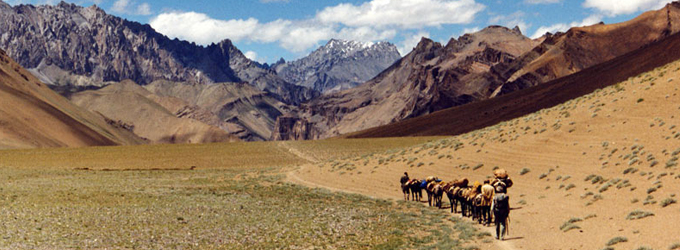Grade : Moderate
Highest point : Shibuk-la
Best period : June to October
Description : This journey starts after a drive to Rumtse around 85 kms from Leh near the Gya village, which was seat of power of the Head of Ladakh Gyapacho in the 10th century AD. It crosses three passes before Tsokar Lake and another three passes after Tsokar the salt Lake. While trekking in this area, you can visit birds, wild animals and Changpa nomades grazing their herds of goats at the mountains and high passes. The mid point of the trek is Tsomoriri Lake or Korzok, the head quarter of Nomadic people. Explore Tsomoriri Lake for a day and trek further to Kibber via Parang La.
This is a unique trek across the Rupshu region in south east Ladakh- it is a starkly beautiful region of high-altitude arid plains, gentle mountain ranges and salt-water lakes, such as Tso Kar and Tso Moriri, with the only inhabitants being pastoral nomads. We will spend seven days crossing this region while going over a number of high passes before reaching the salt-water lake of Tso Moriri.
The combination of a cultural exploration of the rich Buddhist culture of Ladakh and a challenging trek in the high desert plateau makes this a distinctive Himalayan journey.
Day 1. Sightseeing Hemis, Thiksay monastery and Shey palace
The old Shey palace of the Ladakh built in 550 years ago by the first king Lhachan Splagyion of Ladakh and the palace has largest golden Buddha statue in Ladakh, the statue worked out of gold and gilded copper sheet was built in 17th century. From the palace you can have a look over the fertile Indus plain and the Indus to Zanskar mountain range.
Thiksay monastery is the oldest monastery of Gelugpa School in Ladakh on the prophesy of great Lama Tsongkhapa the founder of Gylukpa school his disciples great Lama Sharap Zangpo of stod and his nephew Paldan Sharap built the monastery on the bank of Indus river in 14th century and this monastery is as beautiful as comparison to Potala palace and it is known as mini Potala. In 1980 the giant statue of future Buddha was erected and the monastery has largest contingents of monks in Ladakh.
Hemis monastery is located in the hidden mountain of Stok range, Hemis monastery is the school of Drukpa of Tibetan Buddhism was founded by the first reincarnation of Lama Stakstang Raspa from Tibet in 16th century with the support of ladakhi King Sengay Namgail. The festival of this monastery is very popular which held in summer.
Day 2: RUMTSE to Kyamer. 4 to 5hrs
The first day trek will begins toward north eastern side from Rumtse after leaving the leh Manali road to the right side and the trekking leads you toward Kyamer valley after crossing two little river. The rough trail is same all the way to Kymer and again you need to cross same river later you will reach at shepherd camp.
Day 3: KYAMAR to TISALING (5-6 hrs)
The second day trek starts with gentle climbing which take to kumur-la 4870 meters. From the top the trail divert into two different route and you have to flow the right hand side and ascend for short while then downhill valley, from here to trace the trekking route is not so easy keep ahead to the opposite small valley toward east and for the another pass you have tough climbing up takes you Mandalchen –la 4996meters and then continuously trekking toward the campsite which lies below the pass. The camping is spacious and near the stream.
Day 4. TISALING - PANGUNAGU (5-6 hrs)
Today hiking is not so hard and we have one pass Shibuk-la pass 4900 meters, from the top of pass we can have view of Tsokar lake and long gentle descend walking towards the tsokar lake through desert valley we will see wild ass and black necked crane on the way and at the lake ages back people of Changthang used to produce salt. Camping is near lake.
Day 5: PANGUNAGU - NURUCHAN (4-5 hrs)
Wake up early morning to have the view of the lake and later you can start the day trek along the lake while watching birds and the beautiful landscape, to the other side of lake you will see village and Gonpa of tsokar. Later you turn to right side of the lake and on way passé many Mantra wall which having fine engrave mantra of the compassion Buddha that leads to Nuruchen village. Camping near the stream with crystal water.
Day 6: NURUCHEN to RAJUNGKARU (5 Hrs)
The hiking to the hormalkongma –la 4900 Mt, takes one and half hour and the trails leads you to north with an easy climbing after the river we have another small pass that reach you to Gyama Loma. From there we can have an excellent view of group of peaks and then follows by easy walk to the wide valley after the two small rivers crossing you reach to the camping place.
Here we can see and experience the nomad of Tibetan refugees stay and their real life way of living of the Tibetan nomad in Tibet with sheep, pashmina goat and the yaks.
Day 7: RAJUNGKARU to Gyamalhoma 6 to 7 hrs
Right from the camp ascending starts toward the pass Kyamayur-la 5120meters it will take approximately two hours you will see some beautiful snow caps and the last part of pass is enjoyable. And continue walking towards northeast of the valley and then from here start again ascending a pass named Gyami-la 5100meter and also from the pass you will see magnificent views several peaks and walk downhill continuously to northeast after crossing the stream you will reach to the base of NYalangyugu .camp.
Day 8. Gyamalhoma to Korzok tsomoriri lake4500meters. 6 to 7 hrs
The last day of trek ascend to the Nyalangyugu-la 5100 meters and walking along the stream easily takes you to the pass, from the top of the pass you could see Tsomoriri a beautiful lake with an encompassing of several peaks and amazing view of landscape, afterward walk down left side of the hill with zigzag trail which will reach you to the nomad pastureland of summer camp of korzok village and then continuously walk along the stream to reach Korzok village, a nomadic head quarter near the Tsomoriri lake.



